GMC SIERRA CLASSIC 2007 Owners Manual
Manufacturer: GMC, Model Year: 2007, Model line: SIERRA CLASSIC, Model: GMC SIERRA CLASSIC 2007Pages: 674, PDF Size: 3.5 MB
Page 241 of 674

Sensors
The solar sensor, located in the defrost grille, that
is in the middle of the instrument panel, monitors
the solar radiation. Do not cover the solar
sensor or the system will not work properly.There is an interior temperature sensor located
next to the steering wheel that measures the
temperature of the air inside your vehicle.
There is also an exterior temperature sensor
located behind the front grille. This sensor reads
the outside air temperature and helps maintain the
temperature inside the vehicle. Any cover on
the front of the vehicle could cause a false reading
in the displayed temperature.
241
Page 242 of 674
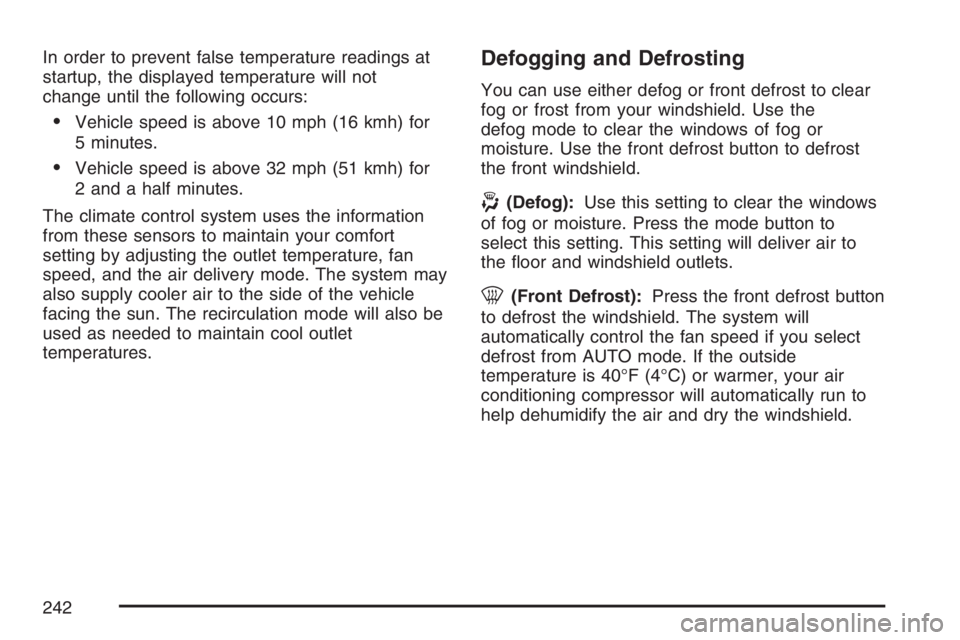
In order to prevent false temperature readings at
startup, the displayed temperature will not
change until the following occurs:
Vehicle speed is above 10 mph (16 kmh) for
5 minutes.
Vehicle speed is above 32 mph (51 kmh) for
2 and a half minutes.
The climate control system uses the information
from these sensors to maintain your comfort
setting by adjusting the outlet temperature, fan
speed, and the air delivery mode. The system may
also supply cooler air to the side of the vehicle
facing the sun. The recirculation mode will also be
used as needed to maintain cool outlet
temperatures.
Defogging and Defrosting
You can use either defog or front defrost to clear
fog or frost from your windshield. Use the
defog mode to clear the windows of fog or
moisture. Use the front defrost button to defrost
the front windshield.
-(Defog):Use this setting to clear the windows
of fog or moisture. Press the mode button to
select this setting. This setting will deliver air to
the �oor and windshield outlets.
0(Front Defrost):Press the front defrost button
to defrost the windshield. The system will
automatically control the fan speed if you select
defrost from AUTO mode. If the outside
temperature is 40°F (4°C) or warmer, your air
conditioning compressor will automatically run to
help dehumidify the air and dry the windshield.
242
Page 243 of 674
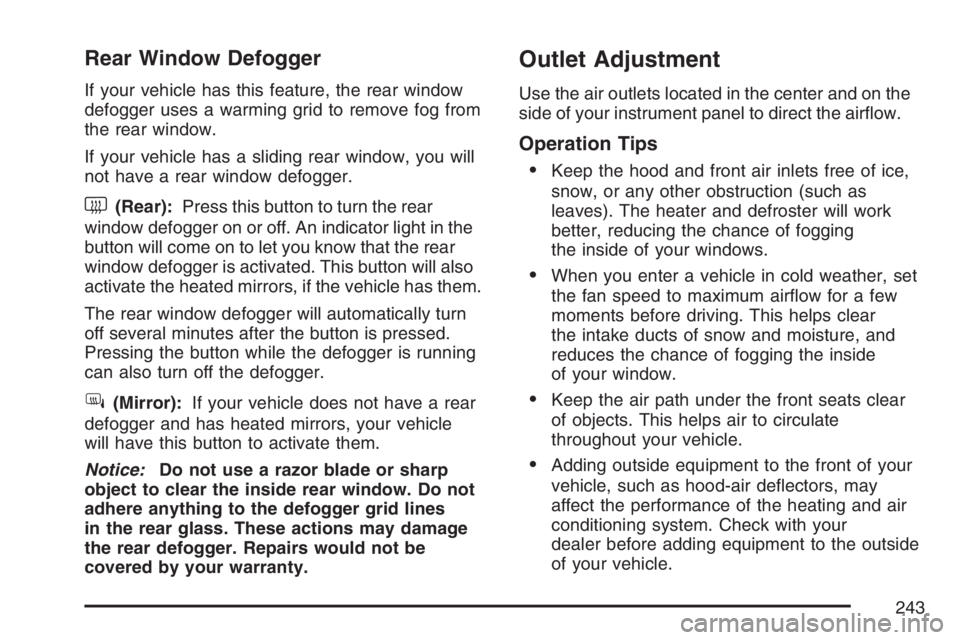
Rear Window Defogger
If your vehicle has this feature, the rear window
defogger uses a warming grid to remove fog from
the rear window.
If your vehicle has a sliding rear window, you will
not have a rear window defogger.
<(Rear):Press this button to turn the rear
window defogger on or off. An indicator light in the
button will come on to let you know that the rear
window defogger is activated. This button will also
activate the heated mirrors, if the vehicle has them.
The rear window defogger will automatically turn
off several minutes after the button is pressed.
Pressing the button while the defogger is running
can also turn off the defogger.
W(Mirror):If your vehicle does not have a rear
defogger and has heated mirrors, your vehicle
will have this button to activate them.
Notice:Do not use a razor blade or sharp
object to clear the inside rear window. Do not
adhere anything to the defogger grid lines
in the rear glass. These actions may damage
the rear defogger. Repairs would not be
covered by your warranty.
Outlet Adjustment
Use the air outlets located in the center and on the
side of your instrument panel to direct the air�ow.
Operation Tips
Keep the hood and front air inlets free of ice,
snow, or any other obstruction (such as
leaves). The heater and defroster will work
better, reducing the chance of fogging
the inside of your windows.
When you enter a vehicle in cold weather, set
the fan speed to maximum air�ow for a few
moments before driving. This helps clear
the intake ducts of snow and moisture, and
reduces the chance of fogging the inside
of your window.
Keep the air path under the front seats clear
of objects. This helps air to circulate
throughout your vehicle.
Adding outside equipment to the front of your
vehicle, such as hood-air de�ectors, may
affect the performance of the heating and air
conditioning system. Check with your
dealer before adding equipment to the outside
of your vehicle.
243
Page 244 of 674
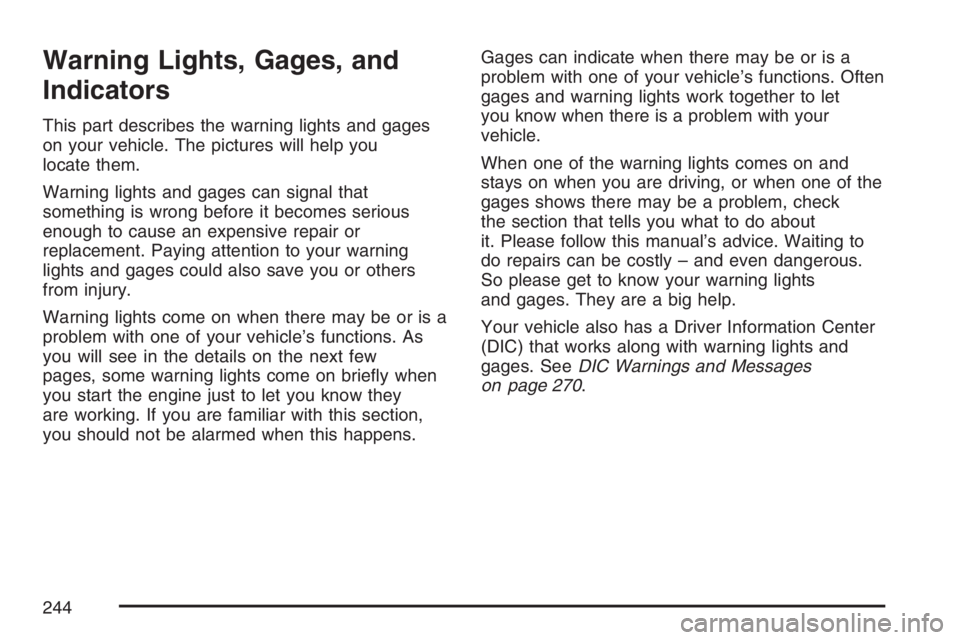
Warning Lights, Gages, and
Indicators
This part describes the warning lights and gages
on your vehicle. The pictures will help you
locate them.
Warning lights and gages can signal that
something is wrong before it becomes serious
enough to cause an expensive repair or
replacement. Paying attention to your warning
lights and gages could also save you or others
from injury.
Warning lights come on when there may be or is a
problem with one of your vehicle’s functions. As
you will see in the details on the next few
pages, some warning lights come on brie�y when
you start the engine just to let you know they
are working. If you are familiar with this section,
you should not be alarmed when this happens.Gages can indicate when there may be or is a
problem with one of your vehicle’s functions. Often
gages and warning lights work together to let
you know when there is a problem with your
vehicle.
When one of the warning lights comes on and
stays on when you are driving, or when one of the
gages shows there may be a problem, check
the section that tells you what to do about
it. Please follow this manual’s advice. Waiting to
do repairs can be costly – and even dangerous.
So please get to know your warning lights
and gages. They are a big help.
Your vehicle also has a Driver Information Center
(DIC) that works along with warning lights and
gages. SeeDIC Warnings and Messages
on page 270.
244
Page 245 of 674

Instrument Panel Cluster
Your instrument cluster is designed to let you know at a glance how your vehicle is running. You will
know how fast you are going, about how much fuel you have and many other things you will need to know
to drive safely and economically.
United States Heavy Duty Automatic Transmission version shown. Canada, Light Duty Automatic and Manual
Transmission Clusters similar.
245
Page 246 of 674

Speedometer and Odometer
Your speedometer lets you see your speed in both
miles per hour (mph) and kilometers per hour
(km/h). Your odometer shows how far your vehicle
has been driven, in either miles (used in the
United States) or kilometers (used in Canada).
Engine Hour Meter Display
The Driver Information Center (DIC) can also
display the number of hours the engine has run.
To display the hour meter, turn the ignition
off, press and hold the reset button for at least
four seconds. The hour meter will be displayed for
up to 30 seconds, or until the ignition is turned
on. SeeDIC Operation and Displays on page 266
for more information.
Trip Odometer
The trip odometer can tell you how far your
vehicle has been driven since you last set the trip
odometer to zero.
Press the reset button, located on the instrument
panel cluster next to the trip odometer display,
to toggle between the trip odometer and the
regular odometer. Holding the reset button for
approximately one second while the trip odometer
is displayed will reset it.
To display the odometer reading with the ignition
off, press the reset button.
SeeDIC Operation and Displays on page 266for
more information.
Tachometer
Your tachometer displays the engine speed in
revolutions per minute (rpm). See “Grade Braking
(Allison Transmission
®)” underTow/Haul Mode
on page 147for more information.
Notice:If you operate the engine with the
tachometer in the solid red area, your vehicle
could be damaged. The damages would
not be covered by your warranty. Do not
operate the engine in the solid red area.
246
Page 247 of 674
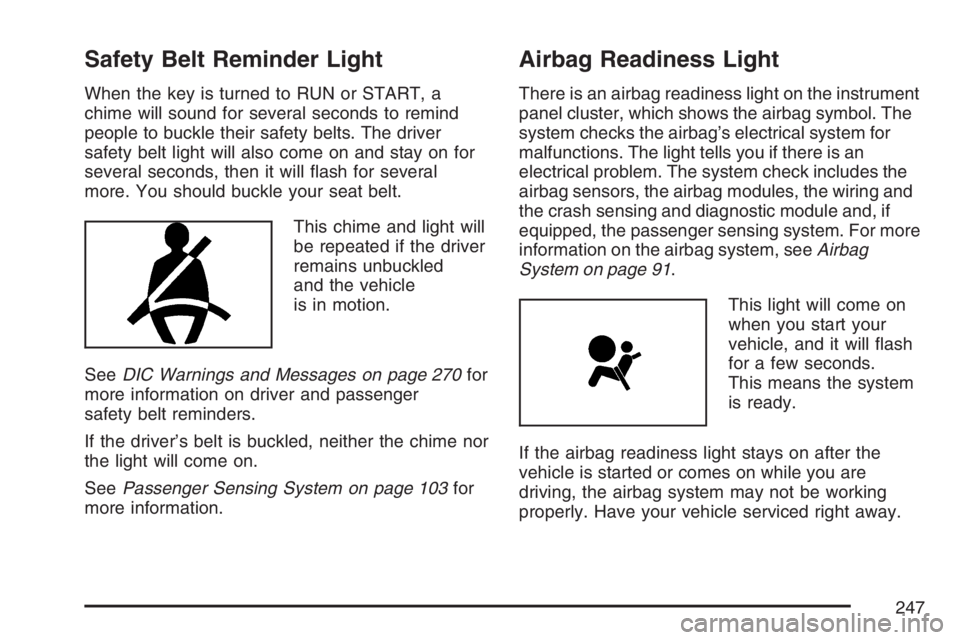
Safety Belt Reminder Light
When the key is turned to RUN or START, a
chime will sound for several seconds to remind
people to buckle their safety belts. The driver
safety belt light will also come on and stay on for
several seconds, then it will �ash for several
more. You should buckle your seat belt.
This chime and light will
be repeated if the driver
remains unbuckled
and the vehicle
is in motion.
SeeDIC Warnings and Messages on page 270for
more information on driver and passenger
safety belt reminders.
If the driver’s belt is buckled, neither the chime nor
the light will come on.
SeePassenger Sensing System on page 103for
more information.
Airbag Readiness Light
There is an airbag readiness light on the instrument
panel cluster, which shows the airbag symbol. The
system checks the airbag’s electrical system for
malfunctions. The light tells you if there is an
electrical problem. The system check includes the
airbag sensors, the airbag modules, the wiring and
the crash sensing and diagnostic module and, if
equipped, the passenger sensing system. For more
information on the airbag system, seeAirbag
System on page 91.
This light will come on
when you start your
vehicle, and it will �ash
for a few seconds.
This means the system
is ready.
If the airbag readiness light stays on after the
vehicle is started or comes on while you are
driving, the airbag system may not be working
properly. Have your vehicle serviced right away.
247
Page 248 of 674
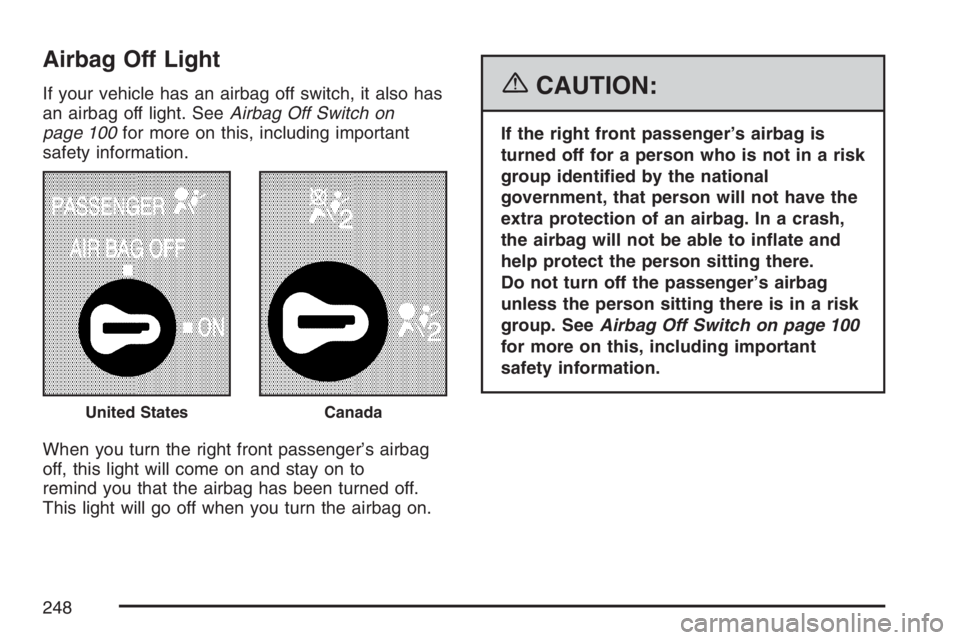
Airbag Off Light
If your vehicle has an airbag off switch, it also has
an airbag off light. SeeAirbag Off Switch on
page 100for more on this, including important
safety information.
When you turn the right front passenger’s airbag
off, this light will come on and stay on to
remind you that the airbag has been turned off.
This light will go off when you turn the airbag on.{CAUTION:
If the right front passenger’s airbag is
turned off for a person who is not in a risk
group identi�ed by the national
government, that person will not have the
extra protection of an airbag. In a crash,
the airbag will not be able to in�ate and
help protect the person sitting there.
Do not turn off the passenger’s airbag
unless the person sitting there is in a risk
group. SeeAirbag Off Switch on page 100
for more on this, including important
safety information.
United StatesCanada
248
Page 249 of 674
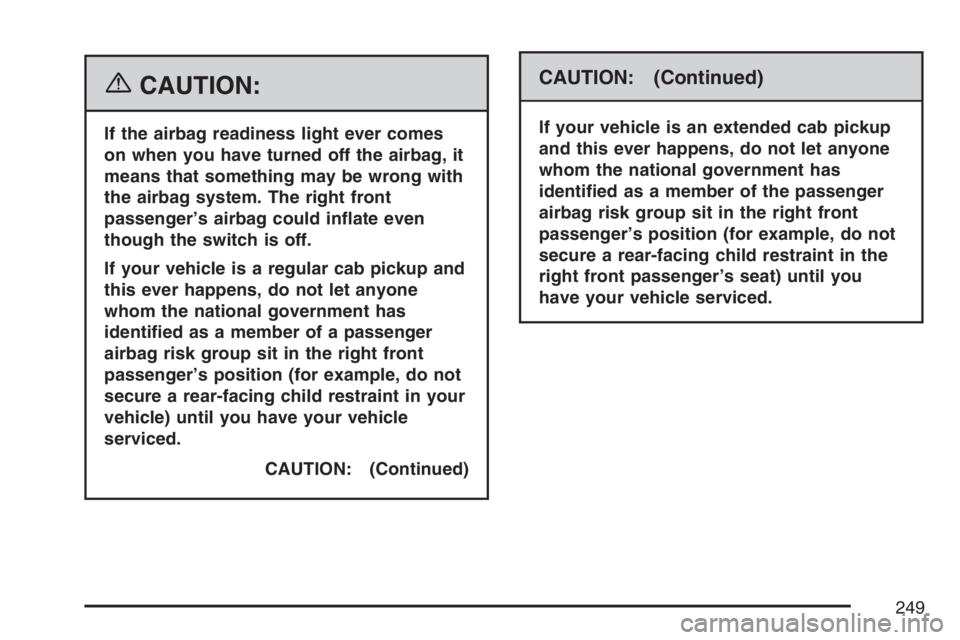
{CAUTION:
If the airbag readiness light ever comes
on when you have turned off the airbag, it
means that something may be wrong with
the airbag system. The right front
passenger’s airbag could in�ate even
though the switch is off.
If your vehicle is a regular cab pickup and
this ever happens, do not let anyone
whom the national government has
identi�ed as a member of a passenger
airbag risk group sit in the right front
passenger’s position (for example, do not
secure a rear-facing child restraint in your
vehicle) until you have your vehicle
serviced.
CAUTION: (Continued)
CAUTION: (Continued)
If your vehicle is an extended cab pickup
and this ever happens, do not let anyone
whom the national government has
identi�ed as a member of the passenger
airbag risk group sit in the right front
passenger’s position (for example, do not
secure a rear-facing child restraint in the
right front passenger’s seat) until you
have your vehicle serviced.
249
Page 250 of 674
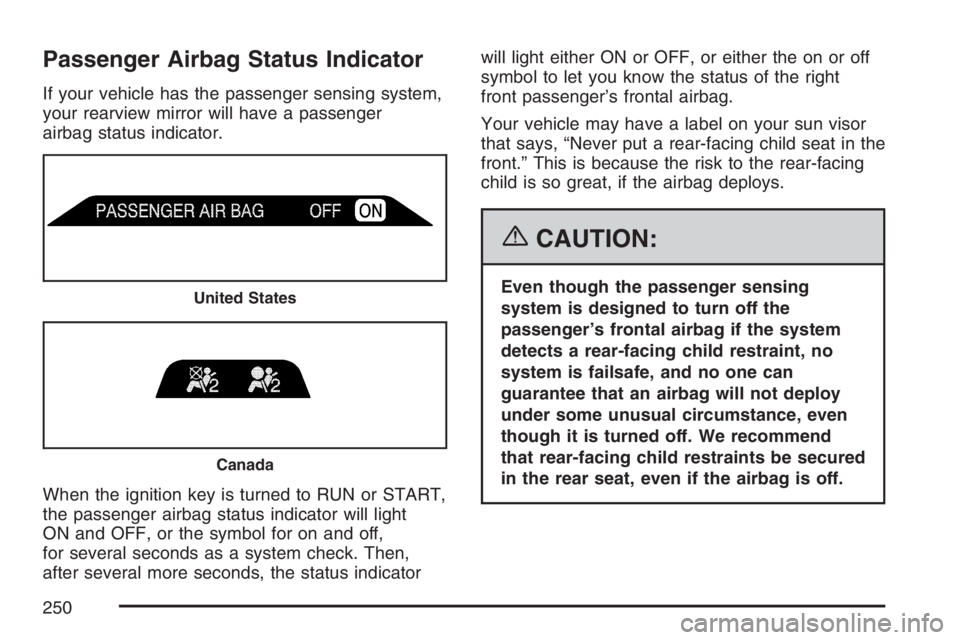
Passenger Airbag Status Indicator
If your vehicle has the passenger sensing system,
your rearview mirror will have a passenger
airbag status indicator.
When the ignition key is turned to RUN or START,
the passenger airbag status indicator will light
ON and OFF, or the symbol for on and off,
for several seconds as a system check. Then,
after several more seconds, the status indicatorwill light either ON or OFF, or either the on or off
symbol to let you know the status of the right
front passenger’s frontal airbag.
Your vehicle may have a label on your sun visor
that says, “Never put a rear-facing child seat in the
front.” This is because the risk to the rear-facing
child is so great, if the airbag deploys.
{CAUTION:
Even though the passenger sensing
system is designed to turn off the
passenger’s frontal airbag if the system
detects a rear-facing child restraint, no
system is failsafe, and no one can
guarantee that an airbag will not deploy
under some unusual circumstance, even
though it is turned off. We recommend
that rear-facing child restraints be secured
in the rear seat, even if the airbag is off.United States
Canada
250